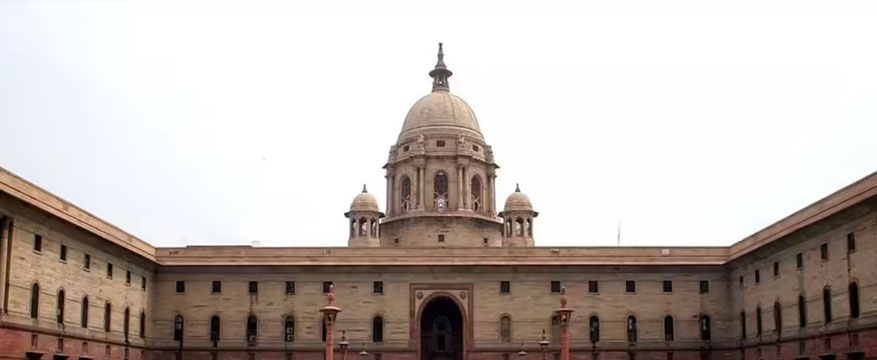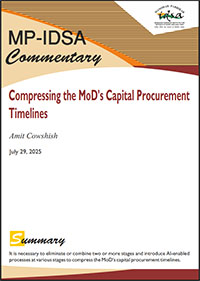Compressing the MoD’s Capital Procurement Timelines
- July 29, 2025 |
- IDSA Comments


One possible approach to compressing the procurement timelines would be to consider the feasibility of combining or eliminating some of the existing stages and pragmatically describe the processes associated with each stage. It is unknown if compression of the prescribed procurement stages is being considered, but it seems unlikely, given that the number of stages has increased from 11 in 2002 to 14 in 2020 without any stage being dropped.
According to a report,[ii] the MoD focuses on streamlining three of the 13 stages to compress the timeframe. These relate to the preparation of the Request for Proposal (RfP), Field Evaluation Trials (FET), and negotiations by the Contract Negotiation Committee (CNC). It is challenging to visualise complete abandonment, or combination, of any of these three stages, but such a possibility exists for others.
To illustrate with the help of an example, one of the stages in the acquisition cycle is evaluation of technical offers submitted by the bidders in response to the RfP.[iii] The Technical Evaluation Committee (TEC) comprises user service, maintenance, quality assurance agencies, and finance representatives. For cases involving transfer of technology (ToT) or indigenous design, representatives of the production agency or the Defence Research and Development Organisation (DRDO) are also taken on board.
The TEC is required to examine the extent of variations/differences, if any, in the characteristics of the equipment offered by various vendors vis-à-vis the Qualitative Requirements (QRs) and other RfP conditions and prepare a ‘Compliance Statement’ shortlisting the equipment for trials/induction into service. Non-compliance of vendors with any of the required provisions results in rejection of the bid at this stage.
The technical evaluation must be concluded within four weeks, and a report must be submitted to the procurement directorate concerned in the Service Headquarters (SHQ) for approval. In case any vendor is found to be non-compliant or the case involves ToT or additional reward for higher indigenous content (IC), the report has to be routed through the Additional Director General (Acquisition-Technical) in the Capital Acquisition Wing of the MoD for approval by the Director General (Acquisition) or the designated officer in the SHQ concerned. This depends on whether the RfP was issued under the non-delegated or delegated financial powers.
Evaluating technical offers is a manual job involving ticking the boxes to ensure that the offer complies with all the technical, financial and other requirements mentioned in the RfP. Tasking a committee to carry out this task and prepare a report for approval by the designated authority takes some time, however limited it may be. With AI-enabled processes, this task should be possible to complete with accuracy in virtually no time or even skipped altogether based on self-certification by the bidders and some more safeguards built into the RfP.
This pre-supposes that the requirements mentioned in the RfP are crystal clear and lend themselves to equally categoric responses. How realistic is this assumption? If a committee can take a call on whether a bid is RfP-compliant, a customised AI application can also perform the same task, with greater accuracy and speed to boot.
The vendors and MoD can also use the opportunity the pre-bid meetings offer to ensure that the requirements specified in the RfP are precise. This makes it difficult for the bidders to respond in categorical terms, facilitating AI-enabled processing of their bids.
If this sounds too ambitious, the instances of non-compliant bids (or some parts of a bid) highlighted in the AI-generated report can be subjected to collective examination by an empowered committee to decide whether the bidder should be eliminated from the race or allowed to continue participating.
At any rate, AI-driven processing would make the system more efficient and unbiased and the vendors more accurate and cautious while preparing their technical bids. This would ultimately help compress the timeline by eliminating the need to constitute TECs to prepare the compliance statements and process their reports for approval.
The same example can illustrate the earlier point about the need for clarity about the processes required to be followed at each stage by procurement personnel. The method described in DAP 2020 for the technical evaluation stage is puzzling and leaves many ends untied.
On the one hand, DAP 2020 clearly states that “Non-compliance of vendors to any of the required provisions would lead to rejection of the bid at this stage”.[iv] On the other hand, it also says that
TEC will examine the extent of variations/differences, if any, in the characteristics of the equipment offered by various vendors concerning the QRs as given (in the RfP) and prepare a ‘Compliance Statement’ short listing the equipment for trials/induction into service, as applicable.
The plain understanding of the first part would be that if a bid varies or differs from the RfP requirements, it is non-compliant and, therefore, liable to be rejected. But the second part seems to suggest that the TEC can take a call on whether, despite the variations/differences, the equipment could be shortlisted for trials, without making it clear as to what kind of variations or differences would not warrant rejection of the bid.
This uncertainty is further exacerbated by the provision that while technical offers cannot undergo any material changes once these are submitted, minor variations, which do not affect the basic character/profile of the offer, may be acceptable, to ensure fair play. An opportunity to revise minor technical details should be given to all vendors equally. This is provided that no extra time is given to any vendor to upgrade their product (except in the case of Essential Parameters-B), the QRs are not diluted, and the vendors do not revise the original commercial quote submitted earlier.[v]
This opens the proverbial Pandora’s Box. The process defined in DAP 2020 leaves it to the subjective understanding of the TEC to decide whether to shortlist the equipment despite the noticed variations/differences. What are the ‘material changes’ and ‘minor variations’? Again, they are not defined and, therefore, are open to subjective and varying interpretations. Besides introducing subjectivity in the acquisition process, such issues also increase the personal risks for the procurement personnel deciding such matters. Ultimately, it impinges on quick decision-making.
The space constraint does not permit elaboration of the approach suggested in this commentary by giving more examples. The underlying argument is that if the procurement timelines are to be compressed, it is necessary to step out of the comfort zone and consider the possibility of doing away with or combining two or more stages, introducing AI-enabled processing at various stages, and more importantly, refining the processes related to each stage so that they are immediately implementable and do not call for the exercise of extensive subjective judgement.
Views expressed are of the author and do not necessarily reflect the views of the Manohar Parrikar IDSA or of the Government of India.
[i] “Defence Acquisition Procedure (DAP 2020)”, Ministry of Defence, Government of India.
[ii] Rahul Singh, “India Working to Cut Arms-Buying Timeline”, Hindustan Times, 17 July 2025.
[iii] “Defence Acquisition Procedure (DAP 2020)”, no. 1, paras 59 to 62.
[iv] Ibid., para 59.
[v] Ibid., para 60.






